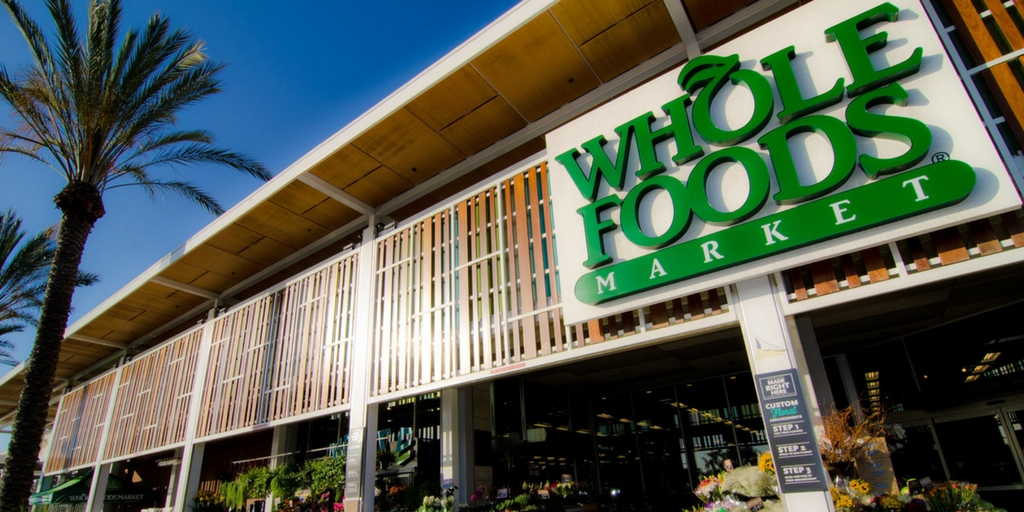
by Jennifer Hart Yim | Jul 26, 2017 | Blog, Current Events, Logistics, Strategy, Supply Chain
Amazon’s foray into the grocery space has larger implications for its overall strategy, and the possible benefits for the eCommerce goliath are diverse.
This guest post comes to us from Argentus Supply Chain Recruiting, a boutique recruitment firm specializing in Supply Chain Management and Procurement.
Big news out of the grocery retail world as Amazon has announced its acquisition of major organic foods retailer Whole Foods Market – for an eye-popping $13.7 billion sale price that doesn’t look so massive given Amazon’s $136 billion sales volume in 2016.
Analysts across the retail industry are talking about the huge implications of this sale for a retail industry that many say is in the middle of a major meltdown, in part owing to Amazon’s massive growth in the eCommerce space. This foray into the grocery business is a big challenge to companies like Target, Wal-Mart, and others, and also a sign that reports of brick and mortar retail’s demise might be greatly exaggerated.
Anyone following the industry probably isn’t completely surprised by the acquisition, which serves as another example of Amazon’s constantly widening footprint across all aspects of Supply Chain. It follows on the company’s gradual conquest of the logistics space over the last few years, including the licensing of 20 Boeing 767 air cargo jets, the acquisition of wholesale shipping licenses, and forays into trucking. It shouldn’t be so surprising that the company is seeking to put one of the final puzzle pieces in place towards a completely vertically-integrated retail Supply Chain by buying brick and mortar stores – while also buying a major staging ground to improve its last-mile logistics, which is often said to be the “holy grail of eCommerce.”
It all fits into analysts’ understanding of Amazon’s quest for world domination.
That being said, the specific acquisition of a healthy lifestyle brand like Whole Foods is intriguing for sure. This is a brand with major goodwill and solid growth as consumers have looked to healthier choices over the past several years, so it makes sense from that perspective. But as many outlets have reported, Amazon’s foray into the grocery space has larger implications for its overall strategy, and the possible benefits for the eCommerce goliath are diverse. As Supply Chain 24/7 put it, this move is more than a disruption to retail – it could be a disruption to all of society.
Woah.
So let’s dive in: what is Amazon’s medium and long game with this acquisition? What are the possible benefits to the company and the potential disruption?
- Amazon gets to reap the sales of a popular and upscale grocery brand.
- It brings Amazon a step closer to perfecting its last-mile delivery strategy, which has been difficult to execute for high-turnover perishable items like groceries.
- It expands the company’s distribution network, adding 440 refrigerated warehouses within 10 miles of 80 percent of the population.
- It allows Amazon to place pressure on food suppliers’ profit margins by being even larger.
- It obviously gives the company more physical, brick and mortar presence, which allows it to eliminate some of its disadvantages compared to brick and mortar chains – for example the fact that people shopping online on Amazon can’t try on clothes or select fruit. The company has already dipped its toe into the brick and mortar waters with its Amazon Bookstores, now up to eight locations, but this represents a full-blown cannonball into that space, selling way more than just books.
- It allows the company to digitize the strongest parts of Whole Foods’ brick and mortar experience, adopting a hybridized approach at the same time as Wal-Mart looks to become more like Amazon.
- It allows the company a larger testing ground for its Amazon Go app, which allows customers to pay for grocery goods using a smart phone without ever interacting with a checkout counter. This has negative employment implications, obviously, for retail workers long-term.
- It gives the company more “touch points” with shoppers and avenues to sell higher-margin goods such as Kindle devices in grocery stores.
- It also delivers a massive new client to Amazon Web Services, a client who is currently using Microsoft’s Azure Cloud platform.
- It puts a number of Amazon’s biggest retail rivals on notice, including Target, Wal-Mart, and others, that they can expect more price competition.
When this move was reported, it sent stocks for Canadian grocery companies into a conniption, with some companies losing 3.5% of their value in a day’s trading. American grocery companies didn’t do much better, with Target, Walmart and Kroger all losing value as well. Whatever the outcome, it looks like this year’s retail industry upheavals might just be a taste of what’s to come.
This post originally appeared on the Argentus blog.
Related posts:


by Fronetics | Jul 3, 2017 | Blog, Content Marketing, Current Events, Marketing, Supply Chain
Blog aggregation site Feedspot included Fronetics’ blog on its list of the best content for the supply chain.
Fronetics is honored to learn that our blog has been included on Feedspot’s list of the top 75 supply chain blogs and websites for supply chain professionals. The blog aggregation website has indexed thousands of supply chain blogs and pulled out the most popular using search and social metrics.
Feedspot explains its methodology. “These blogs are ranked based on following criteria:
- “Google reputation and Google search ranking
- “Influence and popularity on Facebook, Twitter and other social media sites
- “Quality and consistency of posts.
- “Feedspot’s editorial team and expert review.”
We are in excellent company on this list. And we love seeing friends and frequent content collaborators like Argentus and SCM Talent Group among the best of the best as well. These are the places where we turn for supply chain thought leadership, and are humbled to be included.
Fronetics strives to be a leading industry resource for information about digital and content marketing, so it is very exciting to be recognized in this way. Thank you to Feedspot, our contributors, and all of our readers who turn to Fronetics for the latest information about content marketing, social media, and more news and happenings in the supply chain industry.
Related posts:

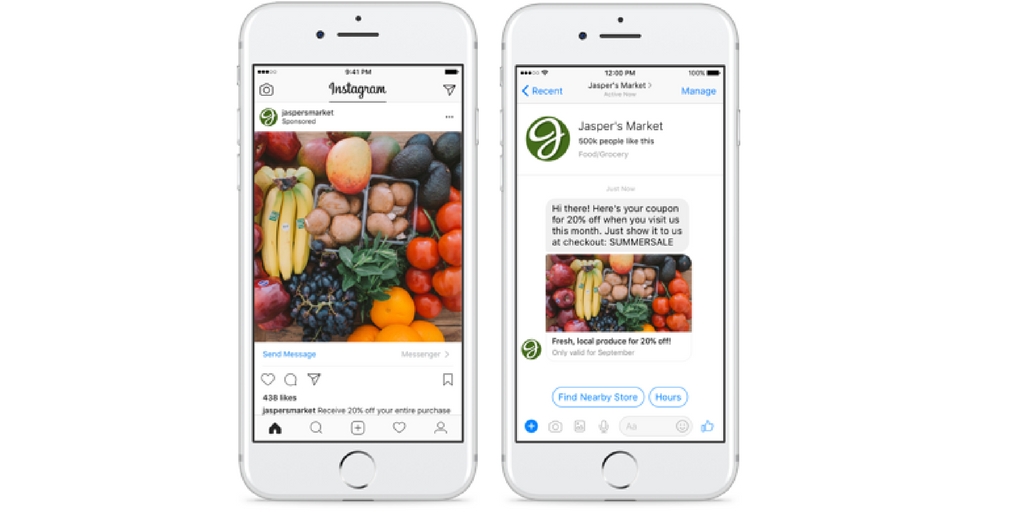
by Fronetics | Jun 28, 2017 | Blog, Current Events, Marketing, Social Media
In June’s social media news, more social media platforms are making changes to benefit businesses who advertise.
June has seen a lot of recent changes in big-name platforms, like Facebook, Instagram and Twitter, that will directly impact the engagement between businesses and potential customers. The trend is to create apps that work harder for paid advertisers, increasing brand awareness for businesses and proving their worth through built-in tracking.
Apple has also been working overtime to keep their products competing with the big players in the social media game. New analytics and introduction of Business Chat are keeping the fruit relevant.
Facebook Rolls Out Two New Ad Campaign Tools for Marketers
Facebook delivered two new options for helping businesses grow: Valued Optimization and Lookalike Audiences. The first, Valued Optimization, “works by using the purchase values sent from the Facebook pixel to estimate how much a person may spend with your business over a seven-day period. The ad’s bid is then automatically adjusted based on this estimation, allowing campaigns to deliver ads to people likely to spend more with your business at a low cost.” The second, Lookalike Audiences, helps marketers reach people likely to be interested in a business based on people who have visited their site. Read more
Facebook Expands Click to Messenger Ads to Instagram
Facebook continues to expand ways for users to connect directly with businesses. The Click to Messenger ads have been available through Facebook for a while, and now they’re expanding to Instagram. “Instagram Click to Messenger ads let you reach the people you care about on Instagram and engage with them on Messenger.” Read more
Instagram Makes Sponsored Content More Transparent
Last week Instagram introduced a new “paid partnership tag” that will clearly identify sponsored posts on its app. “Partnerships between community creators and businesses are an important part of the Instagram experience, and a healthy community should be open and consistent about paid partnerships.” This new tag will help users determine when posts are influenced by commercial relationships with businesses. Read more
Apple Rolls Out Analytics to Podcast App
During a podcast session at WWDC, the Apple developer conference, Apple announced that its podcast app will now have the ability to give publishers data that tells them just how much of their episodes are actually being listening to. Apple Podcasts app will allow creators to track aggregated data about when users start, stop, and skip within an episode. This data will give podcasts tangible results that were once estimated from the number of downloads a podcast received. Read more
Apple Debuts Business Chat
Business Chat allows real customer service representatives to communicate directly with users through iMessage. According to the Apple Developer site, customers can use this new feature to “find your business and start conversations from Safari, Maps, Spotlight, and Siri.” The Verge reports that “there will be built-in features like Apple Pay and calendar integration, which will allow Business Chat to facilitate purchases without requiring the user to exit the chat.” Read more
Twitter Experiments with New Promotional Features for Sponsored Live Video
After entering into an exclusive partnership with Live Nation, Twitter is experimenting with new features to help promote events featured on LN. New features like an alert that users can set to remind them of the live event or a branded timeline that will put all tweets about the event on one landing page will help strengthen the relationship between Twitter and Live Nation, paving the way for more partnerships with big brands. Read more
Related posts:
![The 2017 4th of July Supply Chain [Infographic]](https://fronetics.com/wp-content/uploads/2024/10/4th-of-july.jpg)
by Fronetics | Jun 27, 2017 | Big Data, Blog, Current Events, Data/Analytics, Logistics, Supply Chain
U.S. Consumers plan to spend a whopping $7.1 billion on cookouts for 4th of July celebrations.
The National Retail Federation reports that 219 million Americans plan to celebrate the 241st Independence Day. Two-thirds plan to attend a cookout, barbecue, or picnic, spending an average of $73.42 per household on food items, up from last year’s $71.34. That’s a lot of hot dogs!
And what’s a Fourth of July celebration without fireworks? 44% of Americans plan to attend a fireworks show or community celebration. The U.S. will use approximately 285.3 million pounds of fireworks, totaling $1.09 billion dollars. More than 15,000 firework displays will glitter the skies to mark the special occasion.
Recognized as the nation’s largest Independence Day celebration, the Macy’s 4th of July Fireworks display attracts more than 3 million spectators live and over 10 million TV viewers. The firework display in Washington, D.C., comes in second with over 700,000 viewers from the nation’s capital.
And due to a number of factors — including strong employment and the low price of gasoline — a record number of people will travel out of town this year to celebrate the holiday. NRF estimates 32.9 million, while AAA estimates it will be closer to 44.2 million travelers.
At Fronetics, we wish you and your family a safe and fun Fourth of July celebration. Here are a few more fun facts to get you into the patriotic spirit.
A 2017 4th of July Infographic for the Supply Chain
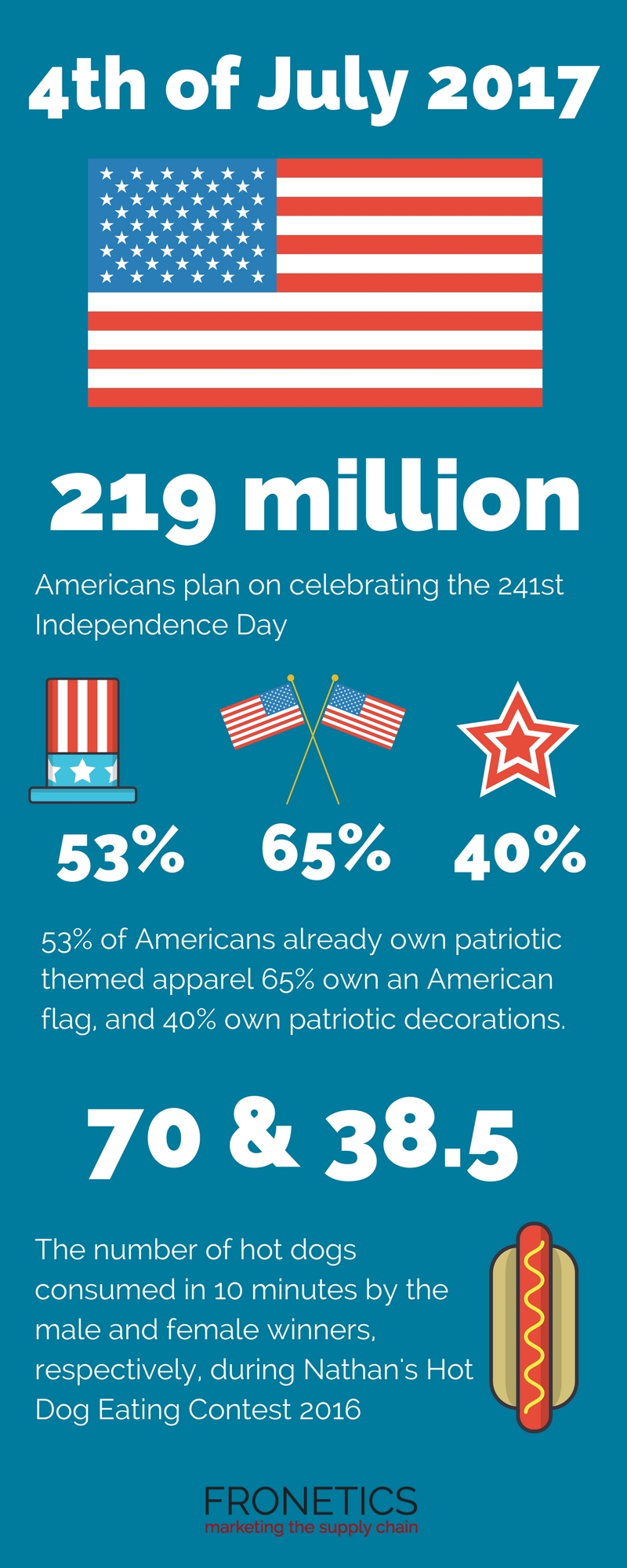
(Made with Canva)
Related posts:
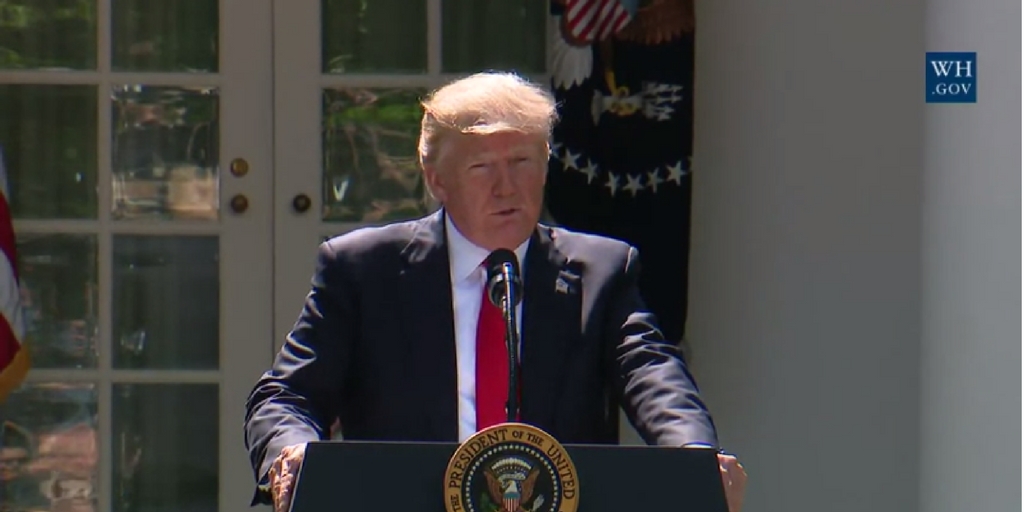
by Fronetics | Jun 21, 2017 | Blog, Current Events, Logistics, Manufacturing & Distribution, Supply Chain, Transportation & Trucking
This post comes to us from Kevin Jessop of Cerasis, a top freight logistics company and truckload freight broker.
The Paris Climate Agreement. Let those words hang for a moment.
Throughout the course of the 2016 election and now the Trump Administration, many Americans have expressed dissatisfaction with the Paris Climate Agreement. True to campaign promises, the new Administration has started the process of removing the U.S. from the agreement, which has major implications for supply chains and shippers around the globe. While the Trump Administration’s impact on supply chains has been discussed previously on Cerasis’ blog, the president’s decision to leave the agreement has shocked the industry, and you need to understand why and what is really going to happen over the next four years.
What Is the Current State of the U.S. in the Paris Climate Agreement?
This may come as a shock, but the Paris Climate Agreement has only been in force since November 4, 2016. As a result, the U.S. has not yet enacted changes under the agreement. The only measure that would have fallen under the Agreement’s terms is the continuation of Customs and Border Protection’s (CBP) rules for maritime statutes.
Lawmakers would have likely passed new legislation to increase environmental scrutiny of supply chains and shippers over the next few years. Moreover, the U.S. would have sent monies to Convention of Countries within the Agreement to help fund eco-conscious goals. The Administration’s actions indicate such changes are not likely to occur, but they could still happen. But, how?
What Is the Timeline for Withdrawal?
The full text of the Paris Climate Agreement is available online through the United Nations Framework Convention on Climate Change (UNFCCC). Article 28 defines the process through which a member of the original Convention may withdraw from the Agreement, and it is a surprise to many to learn that the new Administration cannot simply flip a switch.
Article 28 states that any country wishing to withdrawal may only do so after three years have passed since the agreement went into force. Since the enforcement date was November 4, 2016, a country cannot submit a notification of withdrawal until November 4, 2019. Now, there is another side of the withdrawal.
To prevent countries from withdrawing due to political changes and safeguard the longevity of the planet, any withdrawal still requires a one-year term from the date of notification. In other words, the Administration cannot effectively withdraw from the agreement until at least November 4, 2020.
The 2020 Presidential Election is scheduled for November 3, 2020. This means that if President Trump follows through with submitting a notification of withdrawal in 2019, actual withdrawal will not occur until the day after the 2020 election. Therefore, the question becomes, “How would a notification of withdrawal play out during the election? And if so, will it help or hurt his chances or re-election?”
The precedent for polarization during the previous election cycle indicates President Trump will proceed with plans to withdraw the U.S. from the Agreement when the time comes. The June announcement is merely a call to action to prepare for withdrawal over the next few years. So, what does that mean to both domestic and international supply chains?
The Impact of Withdrawal on Supply Chains.
There are only three countries on the planet, counting the U.S. intention to withdraw, that are not part of the agreement now. This means that every foreign-originating business transaction with U.S. manufacturers, distributors or other partners, except for Syria and Nicaragua, will be at risk. The governments of other countries may look unfavorably at working with U.S. companies due to the new Administration’s plans.
Multiple big-business empires, ranging from Facebook to Goldman Sachs, have condemned the move to withdraw. According to BBC News, part of their rationale is simple. The changes the Agreement dictates reflect existing concerns and actions that many U.S. businesses, including shippers, have already undertaken. Even ExxonMobil, a company whose previous CEO holds the title of Secretary of State, urged the new Administration to remain in the Agreement.
These major companies have already invested time and money in energy-efficienct, eco-conscious programs, and many of their business-to-business partners have followed the same pattern. With the overwhelming majority of the world’s countries committing to this cause, there will be an opening of the “floodgates for businesses, scientists and engineers to unleash high-tech, low-carbon” technologies. As a result, the U.S. could fall further behind the global engineering and science goal, which helps all businesses succeed. In other words, domestic companies may have a more difficult time finding the labor or technologies needed to maintain profitability in the interim.
Is There a Much Darker Side to Withdrawal?
Without getting into a discussion on the science behind global warming, it is important to note things that have happened that may continue if global warming continues. For example, sea levels had risen 2.6 inches from 1993 to 2014, reports the National Oceanic and Atmospheric Administration (NOAA). If left unchecked, numerous ports, businesses, cities and whole seaboards could be lost in the next few decades. To ensure stability and growth along long-term goals, this is a risk that must be mitigated immediately.
The rising sea level is a fact in the heavily disputed conversation about global climate change.
For shippers and supply chains, the risk of not doing anything is too great. Thus, the new Administration means well, but withdrawing from the Agreement is not a change that will impact businesses before 2020. Furthermore, the backlash from the public toward companies that abandon eco-conscious goals could be severe. Shippers could face higher tariffs and additional troubles in shipping goods domestically or abroad.
It is in your company’s best interest to pursue energy-efficiency goals, including working with well-known partners, like Cerasis, to help you reduce waste, eliminate redundancy and continue making healthy profits throughout the future, regardless of who sits in the Oval Office.
This post originally appeared on Cerasis’ blog.
Related posts:
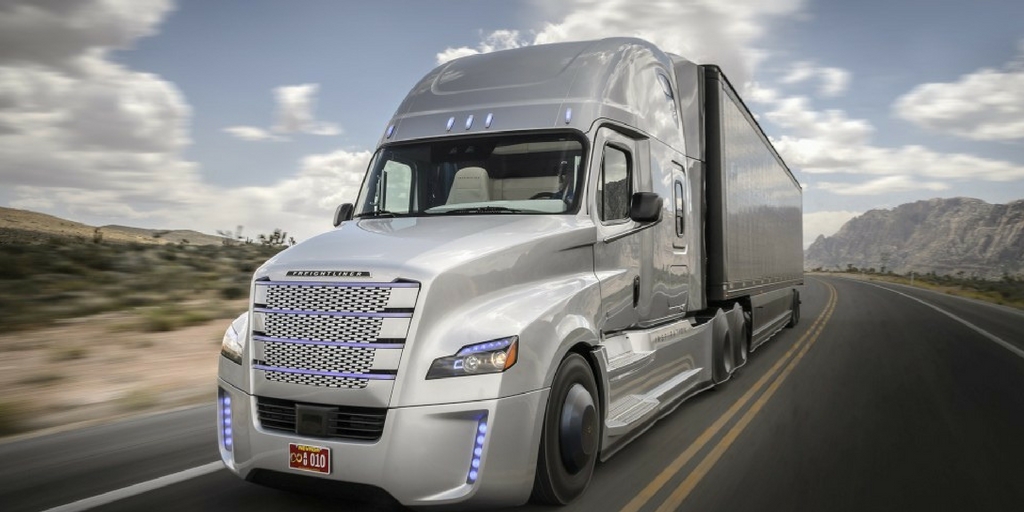
by Elizabeth Hines | Jun 14, 2017 | Blog, Current Events, Logistics, Strategy, Supply Chain, Transportation & Trucking
Startups and transportation juggernauts alike are entering the race toward the self-driving truck, but no two strategies look alike.
There will come a time in the not-so-distant future when — instead of using a CB radio to communicate with a freight driver — you will use a line of code. A recent study conducted by the White House concluded that at least 80% of trucking jobs will be lost to automated technology.
Companies such as Otto (Uber’s robot division), along with start-ups Starsky Robotics, Embark, and Drive.ai are championing the cause of self-driving trucks. These companies are hoping to capitalize on an industry that needs revitalization. With a shortage of about 75,000 jobs and a turnover rate that tops 90%, the current climate is ripe for change.
Self-driving doesn’t mean driverless
Trucking is a $700+ billion industry, with about a third of the costs going to driver compensation. It stands to reason that there is serious incentive to get this technology rolling out onto the highways, removing the need for drivers. However, so far, most plans don’t seem to involve going cold turkey.
Both Otto and Embark will have the automated system take over for the driver when the truck is up and running on the highway. Then once the truck exits, the driver returns to the controls. The benefit of this system is the ease of which the automated driver can navigate highways, as opposed to local roads. Additionally, this system will put less stress on the driver, who can rest while the truck is on the highway.
Starsky Robotics, while not looking to do away with drivers, wants to remove them from the trucks. Starsky’s trucks will be completely autonomous on the highway. Upon exiting, the job will be turned over to trained experts that remotely guide the trucks to their final destinations. Starsky believes by bringing the drivers off the road, and into offices, freights will run more efficiently and on time, while not putting undo stress onto drivers.
While the competition focuses on long-haul trucking, Drive.ai has begun testing automated freight services on around-town delivery vehicles, which it feels is an easier way to introduce its technology. The company says it is developing software to control trucks using a small computer that “learns” how to drive, rather than using complex computers programmed with every conceivable move the vehicle could make.
Bumps in the road
While testing is underway for many of these technologies, not every course has proved smooth sailing. Most notably, Waymo, Google’s self-driving car project, has filed a lawsuit against Uber, accusing the company of using trade secrets taken by Anthony Levandowski, after he left Waymo to found Otto.
Currently, it’s unclear which company will emerge as the leader in the race to automated trucking. What is apparent, though, is there’s no putting the genie back in the bottle.
Automation technology is only becoming more prevalent. With the trucking industry in its current state, it’s only a matter of time before self-driving trucks become the norm.
This article originally appeared on EBN Online.
Related posts:







![The 2017 4th of July Supply Chain [Infographic]](https://fronetics.com/wp-content/uploads/2024/10/4th-of-july.jpg)


